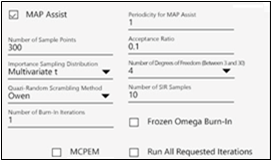Advanced Options for QRPEM only

The following are additional advanced options available only for the QRPEM method.
-
Check the MAP Assist box to perform a maximization of the joint log likelihood before each evaluation of the underlying integrals in order to find the mode.
If checked, enter the Periodicity for MAP Assist in the field. (For example, a value of two specifies that MAP assist should be used every other iteration.)
The importance sampling distribution is centered at this mode value. If MAP Assist is not checked, the mode finding optimization is only done on the first iteration and subsequent iterations use the mean of the conditional distribution as found on the previous iteration. -
Enter the Number of Sample Points in the field.
For each subject, the joint likelihood, the mean, and the covariance integrals will all be evaluated with this number of samples from the designated importance sampling distribution. Increasing this number improves the accuracy of the integrals. -
In the Acceptance Ratio field, enter a decimal value for the acceptance ratio (default is 0.1).
As this value is reduced below 0.1, the importance sampling distribution becomes broader relative to the conditional density. -
Select the importance sampling distribution type from the Importance Sampling Distribution pulldown.
-
Select the Quasi-Random Scrambling Method to use from the pulldown: None, Owen, or Tezuka-Faur.
-
In the Number of SIR Samples field, enter the number of samples per subject used in the Sampling Importance Re-Sampling algorithm to determine the number of SIR samples taken from the empirical discrete distribution that approximates the target conditional distribution.
The number of SIR samples from each subject are merged to form the basis for a log-likelihood optimization that allows fixed effects that are not paired with random effects to be estimated. The number of samples is usually far smaller than the number that would be used if the SIR algorithm were not used.
The default of 10 is usually adequate, unless the number of subjects is extremely small. If necessary, the number of SIR samples can be increased up to a maximum of Number of Sample Points. -
In the Number of Burn-in Iterations field, type the number of QRPEM burn-in iterations to perform at startup to adjust certain internal parameters.
During a burn-in iteration, importance sampling is performed and the three main integrals are evaluated, but no changes are made to the parameters to be estimated or the likelihood. The default is zero, in which case the QRPEM algorithm starts normally. Typical values, other than zero, are 10 to 15. -
Check the Frozen Omega Burn-In box to freeze the omega but not theta for the number of iterations entered in the Number of Burn-In Iterations field.
If this is not checked, then both omega and theta are frozen during the burn-in. -
Check the MCPEM box to use Monte-Carlo sampling instead of Quasi-Random.
Although Quasi-Random is recommended, using Monte-Carlo sampling may be necessary if the most direct comparison possible with other MCPEM algorithms is desired. -
Check the Run All Requested Iterations box to ignore the convergence criteria and run all iterations.
Multivariate Normal (MVN)
Direct sampling
Multivariate Laplace (MVL): The decay rate is exponential in the negative of the sum of absolute values of the sample components. The distribution is not spherically symmetric, but concentrated along the axes defined by the eigenvectors of the covariance matrix. MVL is much faster to compute than MVT.
Multivariate t (MVT): The decay rate is governed by the degrees of freedom: lower values correspond to slower decay and fatter tails.
If selected, enter the Number of Degrees of Freedom in the field. A value between four and 10 is recommended, although any value between three and 30 is valid.
Mixture-2: Two-component defensive mixture. (See T. Hesterberg, “Weighted average importance sampling and defensive mixture distributions,” Tech. report no. 148, Division of Biostatistics, Stanford University, 1991). Both components are Gaussian, have equal mixture weights of 0.5, and are centered at the previous iteration estimate of the posterior mean. both components have a variance covariance matrix, which is a scaled version of the estimated posterior variance covariance matrix from the previous iteration. One component uses a scale factor of 1.0, while the other uses a scale factor determined by the acceptance ratio.
Mixture-3: Three-component defensive mixture. Similar to the two-component case, but with equal mixture weights of 1/3 and scale factors of 1, 2, and the factor determined by the acceptance ratio.
Note:Number of Sample Points, Importance Sampling Distribution, and Acceptance Ratio can all be used to increase or decrease the coverage of the tails of the target conditional distribution by the importance sampling distribution.
